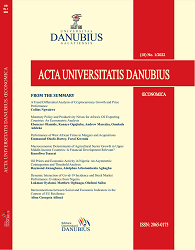Monetary Policy and Productivity Nexus for Oil Exporting African Countries: An Econometric Analysis
Monetary Policy and Productivity Nexus for Oil Exporting African Countries: An Econometric Analysis
Author(s): Ebenezer Olamide, Kanayo Ogujiuba, Andrew Maredza, Omolade AdelekeSubject(s): Business Economy / Management, Labor relations, Economic policy, International relations/trade, Policy, planning, forecast and speculation, Economic development, Fiscal Politics / Budgeting, Accounting - Business Administration
Published by: Editura Universitară Danubius
Keywords: Economic; Growth; Manufacturing; Monetary; Oil; Policy;
Summary/Abstract: The danger of export dependent economies is exposure to external shocks, that weakens the domestic economy, which is evident in countries exporting oil in Africa. The fortunes from increased oil revenue by these countries, have been sabotaged through the same shocks in oil prices, leading to inconsistencies in monetary policy. This article examined responses of monetary policy in oil exporting African countries {OEAC] to oil prices and by extension its effect on manufacturing sector’s productivity. Previous research had mixed results on the relationship with inflation and its effect on growth, leading to an ambivalence as per the effect on manufacturing industries’ output. The error correction panel data method was employed in our investigation and it favours structural dynamism as against dynamism of residuals without the usual factor imposition. Three stages of tests [unit root, cointegration and short/long run estimations] were performed. Long run weak association was observed for monetary policy coefficients and that of the productivity growth rate of the manufacturing unit of OEACs. Both the panel and static results have more influence in the short run than in the long run as far as the monetary policy coefficients are concerned. A substantive positive relationship exists for currency undervaluation as well as the productivity growth rate of the manufacturing section of OEACs. This suggests that a decrease in the price of a currency can influence local production and therefore boost real sector advancement. Our results also confirmed the existence of inverse association between the growth rate of the manufacturing unit plus net domestic credit. It is an outcome that lend credence to existing findings about growth and undervalued currencies in many developing economies.
Journal: Acta Universitatis Danubius. Œconomica
- Issue Year: 18/2022
- Issue No: 1
- Page Range: 21-42
- Page Count: 22
- Language: English

